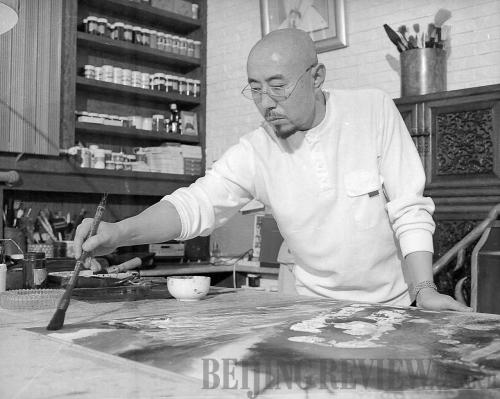|
 |
|
SPLASHING INK: Shao Ge works on an ink painting with an urban theme at his studio in Beijing (COURTESY OF SHAO GE) |
Chinese ink paintings once teetered on the edge of oblivion—at least according to a thesis of a postgraduate art student. Li Xiaoshan from the Nanjing Art College once published a paper titled My View of Chinese Paintings in the Jiangsu Art Monthly. At the time, many Chinese painting professionals, such as Li Kuchan (1899-1983), were passing away without passing on their skills or finding younger artists to fill their shoes. Young artists were left on their own to find breakthroughs and define themselves as artists.
While grossly exaggerated, Li's comment sent shock waves through the Chinese painting community.
Since then, a number of experimental painters have taken to their studios in China, creating many astonishing and inspirational ink paintings using new methods and concepts, marking an important step for the development of contemporary Chinese paintings.
Shao Ge and his urban-themed ink paintings are representatives of this new form. He was the first painter who focused on environmental issues of urbanization in China.
Born to an ordinary family in Beijing in 1962, Shao was keen on traditional Chinese paintings. As a child, he spent much of his time in the Palace Museum, also known as the Forbidden City, staring in wonder at the various delicately produced ink masterpieces on the museum's massive walls. There was an elder man among Shao's family neighbors, who was good at Chinese painting and calligraphy. In his spare time, the kind elder talked about traditional Chinese culture to young Shao. Some years later, Shao decided to study painting after graduating from high school.
Shao entered the Beijing Arts and Crafts School, now the College of Art and Design at the Beijing University of Technology, where he studied painting for three years. The school has fostered many Chinese artists since its founding in 1958. After graduating in 1978, Shao was sent to work at a small crafts factory. Before long, the factory went bankrupt. Shao later passed an exam and became a painter for Rong Bao Zhai, a famous Chinese art gallery established in 1672 during the Qing Dynasty (1644-1911). The gallery markets paintings and calligraphy. This career jump allowed Shao to springboard into a lifetime of ink paintings.
"At first, I just drew everything—landscapes, figures, flowers and birds, fish and insects," Shao said. "But I soon found that sticking to traditional thoughts and skills of Chinese paintings would limit my development as a professional painter. For this reason, I decided to innovate my own style."
 |
|
FAN PAINTING: This ink painting by Shao Ge displaces a traditional Chinese view of unity between humans and nature (COURTESY OF SHAO GE) |
In the late 1980s, experimentalism began to prevail in Chinese painting and helped inspire Shao, who was then struggling to find a breakthrough.
On the whole, experimental Chinese painting is an inevitable outcome of the exchange between Chinese culture and Western culture, and also a combination of traditional thoughts and contemporary society. In the wake of China's reform and opening up in 1978, a spring breeze blew into the realm of culture, waking up the potential of Chinese painters. During the 1990s, robust economic growth led to a multicultural surge in China. Influenced by various thoughts, Chinese paintings began to evolve to embrace diversity and high output with contemporary features.
After preparation and consideration, Shao's creative enthusiasm was eventually ignited. "It was in 1995 when I tried to draw experimental paintings. The initial works came out by chance," Shao said.
| 